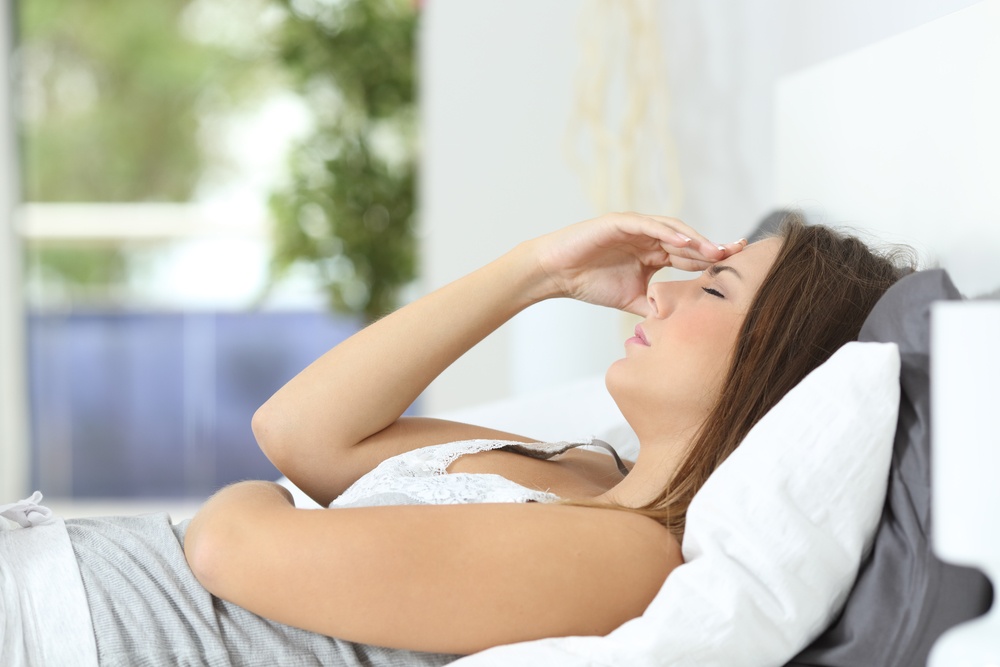
Anyone can get migraines, but women are more likely to do so than men. Patients who develop chronic migraine attacks often have several factors in common, including age, family history, and other medical conditions. Hormones play a primary role in women’s headaches, particularly during the menstrual cycle, and millions of women experience migraines triggered by fluctuating hormones. For those who get migraine attacks before or during their periods, it’s helpful to know about specific treatments could help.
What Menstrual Migraines Are
A menstrual migraine is a headache attack, usually without aura, that occurs during the time frame that begins two days before the onset of a menstrual period and ends around the third day of the period. This type of headache is usually not accompanied by aura and appears to affect around 60 percent of female migraine patients or 10 percent of all women.
How Menstrual Cycles Cause Migraine Attacks
Research shows menstrual migraines are mainly related to dropping estrogen levels, which occurs normally in the two days before and during the first three days of the period.
The female body releases prostaglandin during the first 48 hours of menstruation, and this is also believed to trigger menstrual migraines.
Non-migraine patients can also experience hormonal headaches at the start of a period.
Treating Menstrual Migraines
Modern science is rapidly finding effective new methods of care for migraine sufferers, including:
#1: Triptans
Triptan medications are available in several forms as enhanced acute treatment, including:
- Oral tablets: Fast-acting triptans taken together with non-steroidal anti-inflammatory drugs (NSAIDs) during the early stages can often stop a menstrual migraine in its tracks. Combination drugs include both medications in a dissolvable powder, which is a more rapid method of administering the drug.
- Injections: Some injectable triptans deliver results in less than 10 minutes. They come in both needle and needle-free syringe formats, and even patients experiencing vomiting and extreme nausea can use them easily. The absorption rate of these drugs is much faster than tablets, and they have the added benefit of bypassing the digestive tract. The triptans can be combined with injectable NSAIDs for maximum effect.
- Nasal: For patients unable to stomach consumable drugs or handle the pain of injection, a triptan nasal spray can be effective. Some sprays have to be administered in 4 spurts over a 15-minute period, which can be too slow for a patient experiencing a severe attack.
#2: Birth Control Pills
While some patients find contraceptives make their headaches worse, a number of doctors recommend birth control pills to help migraine sufferers regulate their hormone levels on an ongoing basis. To benefit from hormonal birth control, it’s important to take low doses of estrogen to help you remain balanced during the menstrual cycle. Patients will also often get relief when they take a low-dose estrogen supplement on the days when they use the placebo pills in the contraceptive pack.
#3: Pain Relief Methods
Patients who track their migraine triggers find it possible to identify menstrual migraines by monitoring the start of the attack and comparing it with their cycles. Taking pain relief medication a few days before the headaches usually begin can help prevent the onset of headaches. Over the counter pain relievers, NSAIDs, and using ice packs on the head and neck can all help to reduce the severity of the attack.
Mefenamic acid is a member of the NSAID family and an effective migraine preventative, particularly migraines associated with heavy or painful periods. Patients can take a dose of 500 mg three to four times a day, starting two to three days before the period’s due date. Even in cases of irregular period start dates, mefenamic acid can help if it’s taken on the first day. Most patients only need to take it for a couple of days to experience some relief.
Many pain relievers cause health problems when you take them for extended periods, however, so it’s important not to become dependent on these for relief. Migraineurs who use them frequently can suffer from rebound headaches.
#4: Alternative Therapies
Nature seldom causes a medical condition without providing some relief options for it, and migraine is no exception. Alternative therapies that help some patients include:
- 400 mg of magnesium supplement each day can help lower the pain and inflammation
- Use of essential oils such as lavender or peppermint, applied and massaged into the temples
- 200 to 300 mg of Bromelain (derived from pineapple core) twice daily between meals
- 1,000 mg of ginger twice daily, either alone or combined with turmeric has been shown to be almost as effective as NSAIDs
Acupuncture, biofeedback, and massage are all effective stress and pain relievers that can help you to treat a menstrual migraine attack.
Preventing Menstrual Migraines
Since prevention is always better than having to cure a condition, if you can take steps to avoid an attack at that time of the month so much the better. Work with your migraine doctor to find the best options available, which could include taking prescription pain relievers before your period begins to keep the migraines at bay. Other measures you can take to prevent attacks are:
- Reducing stress: If you’re stressed out either at home or at work, it could be a trigger factor for you. Adopting a lifestyle that limits your stressors can help reduce migraines at any time of the month, and you could find yourself less susceptible to them during your sensitive menstrual period.
- Making lifestyle changes: Follow a healthy diet and avoid trigger foods, especially around your menstrual period. Increase your relaxation with techniques found in yoga and deep breathing. Stop smoking or drinking alcohol, exercise regularly and make sure you get enough sleep.
- Adding supplements to your diet: Ask your migraine doctor about daily supplements that could help to stave off menstrual migraines. Especially if you only get them around the time of your period, following a preventive course could make a significant difference.
- Adding magnesium to your diet: Magnesium helps to relax your blood vessels, and can be found in a supplement or by consuming green, leafy vegetables, seafood, bananas, and beans.
- Taking 400 mg a day of vitamin B2 (riboflavin): This has been proved effective in reducing the number of migraines patients experience, but you need to continue the therapy for up to 3 months before you’ll see any results.
- Feverfiew: Feverfiew is an anti-inflammatory that is beneficial if you take at least 25 mg a day.
- Turmeric: Turmeric works to reduce pain and inflammation and you can get capsules of 1,000 to 2,500 mg to take every day.
- Omega-3 fatty acids: Omega-3 fatty acids help to bring your hormones into balance, but if you can’t handle two to three servings a day you’ll need to use supplements to reach 1,000 to 2,000 daily dosages.
- Hydration: It’s important for your body to get enough water to remain optimally hydrated, or you could trigger migraines at other times than during your menstrual period. Aim to get in 3 liters of fluids a day, in the form of water, herbal teas or clear broths.
Menstrual migraines can make a difficult time of the month even more uncomfortable. If you get regular hormone headaches, consult with your migraine specialist to find ways to reduce your exposure to this condition.



